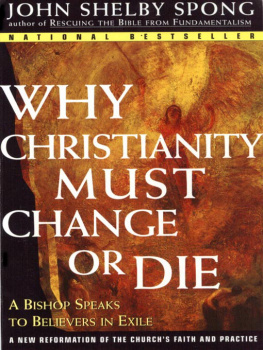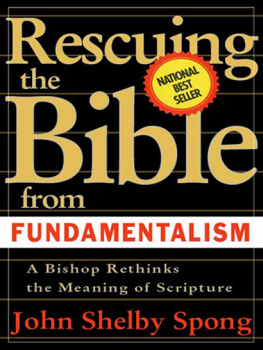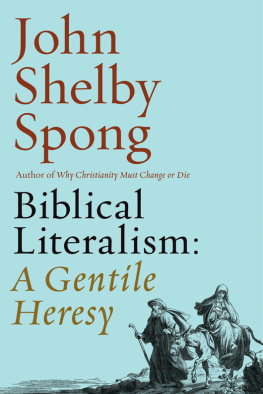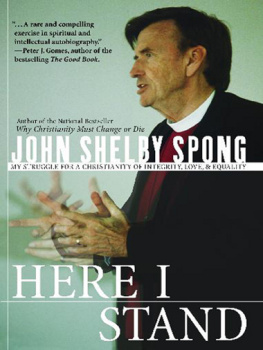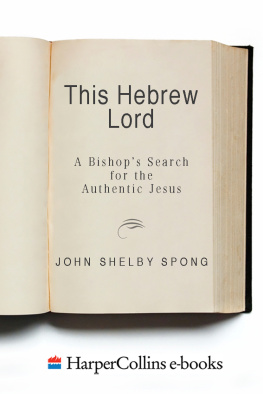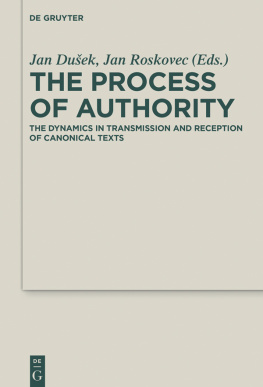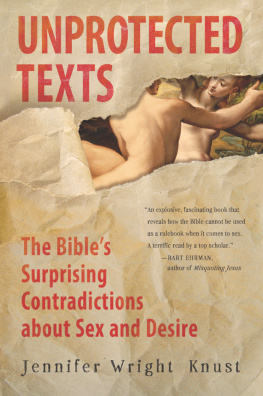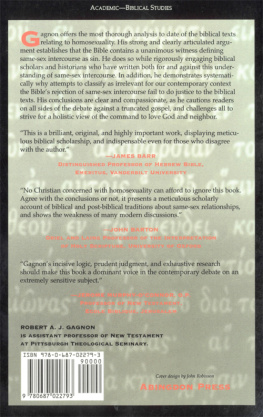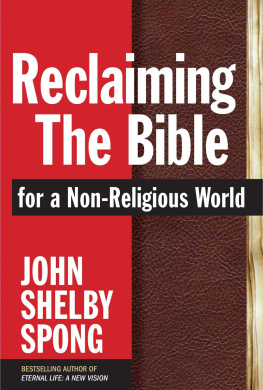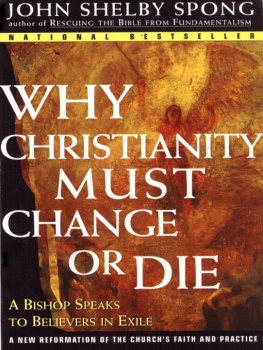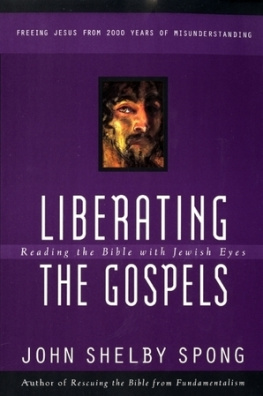THE
SINS OF
SCRIPTURE
Exposing the Bibles Texts of Hate to Reveal the God of Love
JOHN
SHELBY
SPONG

For
CHRISTINE MARY SPONG
My Partner
in Every Sense
of the Word
CONTENTS
Why This Book, This Theme, This Author
A Claim That Cannot Endure 15
The Ethics of Overbreeding
The Virtue of Birth Control
The Earth Fights Back
Bad Theology Creates Bad Ecology
Creation:
The Woman Is Not Made in the Image of God
Sexism in Christian History
The Woman as the Source of Evil
Menstruation and the Male Fear of Blood
Recasting the Negativity
The Ecclesiastical Battle over Homosexuality:
Intense, Irrational, Threatening and Hysterical
The Holiness Code from the Book of Leviticus
The Story of Sodom
The Homophobia of Paul
The Appeal in the Text Spare the Rod
Violence Is Always Violent, Whether the Victim Be a Child or an Adult
God as Judge:
Searching for the Source of the Human Need to Suffer
God as Divine Child Abuser:
The Sadomasochism in the Heart of Christianity
Moving Beyond the Demeaning God into the God of Life
Searching for the Origins of Christian Anti-Semitism
Anti-Semitism in the Gospels
The Role of Judas Iscariot in the Rise of Anti-Semitism
The Circumstances That Brought Judas into the Jesus Story
The Symptoms:
Conversion, Missionary Expansion and Religious Bigotry
Creedal Development in the Christian Church
Since I Have the Truth, No One Comes to the Father, but by Me
My Vision of an Interfaith Future
The Hebrew Scriptures Come into Being
Escaping the Limits of the Epic:
The Prophets, the Writings, the Dream
Jesus and the Jewish Epic
Jesus Beyond Religion:
The Sign of the Kingdom of Godthe Epic Universalized and Humanized
Several years ago we were enjoying an evening with friends, watching the sunset from the deck of their summer home on Fire Island off the southern shore of New York State. I was due to retire in six months and our conversation turned not unnaturally to that issue and what retirement now means, when many people are living healthy, productive lives for twenty or thirty years after the end of their working careers. Retirement is no longer appropriately viewed as one or two years sitting in a rocking chair looking back on life. It was then that our hosts, Phoebe and Jack Ballard, introduced my wife and me to the concept of the third half of life. I was intrigued with this phrase, which the Ballards had used while leading retirement conferences. Their thesis was that if this part of life was to be as long, rewarding and satisfying as the first two halves of our lives had been, it needed to be given similar thoughtful and intentional planning. It was a new and exciting idea.
My father died at age fifty-four; his father at a similar age. Consequently I was not programmed to think in terms of longevity. Yet when I retired as the bishop of Newark I was sixty-eight years old. I had served for twenty-four wonderful and exciting years in that dynamic, mind-stretching and life-giving community of faith. I assumed that it was time to end my professional career and to step out of public life. I had no intention of behaving like many retired bishops who are not able to give up their former symbols of power and influence and thus succeed only in making the lives of their successors miserable. The new bishop of Newark, a good friend and a very able priest, would not have to put up with that. So I severed all connections other than Sunday worship that I had with the Episcopal Church I had served in my forty-five-year career and that I still love very deeply. I was sure I would miss being the bishop, but I intuitively knew that it would be the people with whom I had worked so closely that I would miss rather than the power or position of that office. What I did not know, however, was where I would direct my energies in the future. I had to feel my way into that.
Today, from a vantage point five years removed from my life as the bishop of Newark, I am happy to say that this first part of the third half of life has been the most exciting, the most enjoyable and perhaps even the most creative of all the years that I have known. If this is what the rest of life looks and feels like, then it is the greatest and most incredible part of lifes various adventures.
I originally intended for my last published book to be my autobiography: Here I Stand: My Struggle for a Christianity of Integrity, Love, and Equality . Surely, I thought and stated, one does not write another book after an autobiography has been published. Autobiographies come at the end of life. The first chapters describe ones origins and the last chapter should be the summation of ones life from a vantage point near its end. Perhaps someone might even add to certain autobiographies a postscript to take note of the authors death. My autobiography was set and programmed to come out as I retired, and it was to announce my intended destiny to walk quietly into the sunset! That, however, has not been my experience. Perhaps Ed Stannard, writing about my retirement in the national Episcopal newspaper called Episcopal Life (February 2000), had it right when he concluded his article with these words: His life will be different but dont expect him to keep quiet.
The first sign that I might be in for a surprise came when a letter arrived prior to my retirement inviting me to become the William Belden Noble Lecturer at Harvard University during the first semester of the year 2000. Indeed, that semester began on February 1, the very next day after my official date of retirement. The invitation stated that a requirement of this lectureship was that the lectures had to be publishable. It was that requirement which forced me to think well beyond my work in Why Christianity Must Change or Die and to begin to dream of what the Christianity of the future might look like. The Harvard lectures were destined to form the core of the book A New Christianity for a New World, which was published a year later. That book was not only my second last book, but it was also, along with my other work at Harvard, destined to form the first great opportunity in my third half of life.
The Harvard lectureship was later augmented by an invitation to teach two classes at the Harvard Divinity School and thus it served to focus anew my lifelong commitment to the vocation of teaching as the primary component of my ministry. Prior to my election as bishop, for many years in my parish ministry I had taught an adult class each Sunday morning before the worship service. That class had become the center around which my ministry was organized. While I was bishop, I followed a pattern of delivering twelve to fifteen public lectures a year within the diocese. I also accepted lecture invitations from outside my diocese in which I sought to relate biblical scholarship to scientific, economic and political concerns. I insisted on filtering the biblical stories through the crucible of contemporary knowledge, so making them pertinent to our day.
I also instituted in our diocese a sabbatical program consisting of a three-month study leave for every five years of service for our clergy. I used that time myself not only to set the example for our clergy about the importance of regular, disciplined study time, but also to immerse myself in contemporary biblical scholarship at such places as Union Theological Seminary in New York City, Yale Divinity School, Harvard Divinity School and the storied universities in Edinburgh, Oxford and Cambridge. With that study background and the publication of my books, the orbit of my influence began to extend beyond my diocese and my denomination. When I retired as bishop, to my great surprise the number of invitations I received to lecture literally exploded. Now that I finally had the time to be a full-time teacher I discovered that I would also have the opportunities. In the last five years I have delivered more than two hundred public lectures each year, the venues for which have moved, just as my books have moved, from the United States first to other English-speaking nations of the world and then ultimately to the nations of Europe, Asia and the South Pacific.


